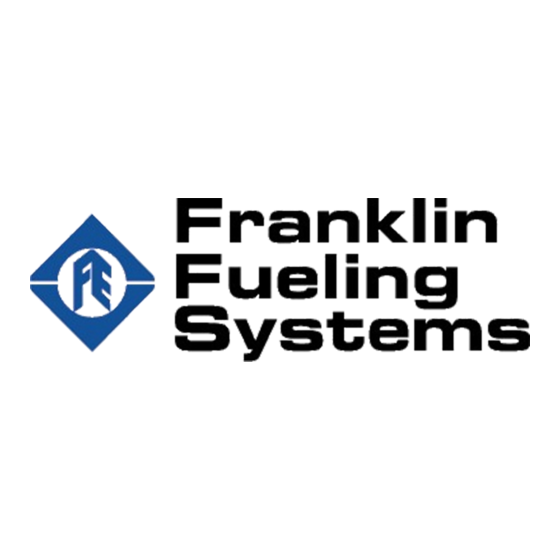Advertisement
Quick Links
Advertisement

Summary of Contents for Franklin Fueling Systems EVO Series
- Page 1 SERIES AUTOMATIC TANK GAUGES POSITIVE SHUTDOWN REFERENCE GUIDE...
- Page 2 Copyright © 2021 Franklin Fueling Systems, LLC, Madison, WI 53718. All world rights reserved. No part of this publication may be stored in a retrieval system, transmitted, or reproduced in any way, including, but not limited to, photocopy, photograph, magnetic, or other record, without the prior written permission of Franklin Fueling Systems.
- Page 3 Introduction The purpose of this guide is to provide instruction on the various methods of achieving positive shutdown of a submersible turbine based on predetermined scenarios. The methods discussed will include the use of relays, Turbine Pump Interface (TPI) and various other means of programming the EVO(TM) Series Automatic Tank Gauge (ATG) console including Rules, Logic Conditions and settings within specific applications.
- Page 4 Intentionally Blank...
- Page 5 Use of Programmed Inputs - TPI and Relays The following illustrations will help understand how the programming of each method can create a positive shutdown given a programmed input under the submersible turbine programming of either turbine pump interface or relay. Turbine Pump Interface (TPI) Turbine Pump Interface (TPI) is a communication protocol and parameter programming subset that allows the EVO™...
- Page 6 The TPI example below shows the controller programmed with six inputs: • AC Input module- hook signals (hook isolation) for dispenser 1-2, 3-4 unleaded. • 4-20mA- LS500 line leak transducer (requirement for Electronic Line Leak Detection (ELLD)) • Provides ability to energize turbine for testing and disable turbine in event of ELLD alarm (positive shutdown) •...
- Page 7 Relay Module The relay modules have two styles: a 10-amp module and a 2-amp module. The 2-amp module is a non-intrinsically safe module that has 8 identical 2-amp SPDT (Single Pole Double Throw) output relays. The 10-amp module has 6 identical 10-amp SPDT output relays. Each channel has a fuse and three terminals.
- Page 8 Relay Module Specifications Number of Channels: 8 Form C Contact Rating: 2A @ 250 VAC 2A @ 30 VDC Switching Current: 2A Max. Relay Wiring Comparisons Switching Power: 1500 VA Max. Relay Module Switching Current 2A Max. Switching Power 1500 VA Max. 110/240 VAC Electrical Panel Line...
- Page 9 Shutdown On Alarm On EVO 200/400/600/6000, the Pumps section of Configuration is used to configure pumps operated using either TPI or Relays. Each Pump has a section called "Shutdown On Alarm", by adding alarms in this section specific sensors or even specific alarms from a given sensor can be assigned to perform positive shutdown on each pump.
- Page 10 Intentionally Blank...
- Page 11 Logic Conditions For the purpose of positive shutdowns, logic conditions use a status based approach typically combined with OR logic. This approach allows the console to be configured with multiple devices and multiple alarms under one condition and ties these status conditions to one or more programmed outputs.
- Page 12 Conditions...
- Page 13 Condition Output • The condition output examples show both options of a relay module or TPI being used. Typically, you would only use one or the other method (TPI or Relay) for submersible motor control. • Condition outputs are programmed outcomes based on the status of any programmed condition inputs.
- Page 14 Intentionally Blank...
-
Page 15: Rules Engine
Rules Engine Rules are another method of programming the EVO™ for positive shutdown. Rules are event based in comparison to conditions that are status based. Using rules for positive shutdown has limitations. Rules as programmed operate independently from one another and for this reason can lead to undesired results. - Page 16 Intentionally Blank...
- Page 17 Application Specific Shutdown Positive shutdown programming is simplified within the Electronic Line Leak Detection (ELLD) application. The ability to provide positive shutdown is simply selecting Yes or No under the programming parameter sections of the specific applications. ELLD The ELLD (Electronic Line Leak Detection) positive shutdown for a 3 GPH gross Line leak fail is hardcoded into the software as this is an EPA requirement.
- Page 18 Intentionally Blank...
- Page 19 Intentionally Blank...
- Page 20 10000007526 r1...






Need help?
Do you have a question about the EVO Series and is the answer not in the manual?
Questions and answers